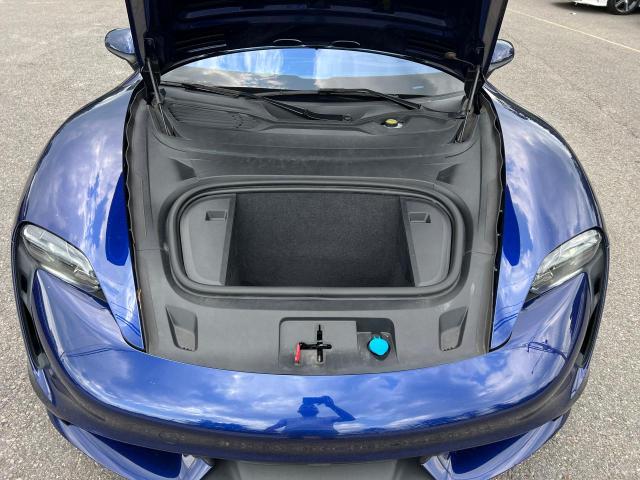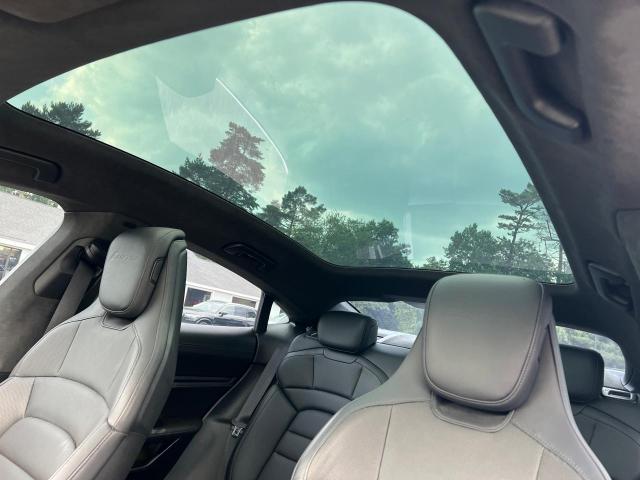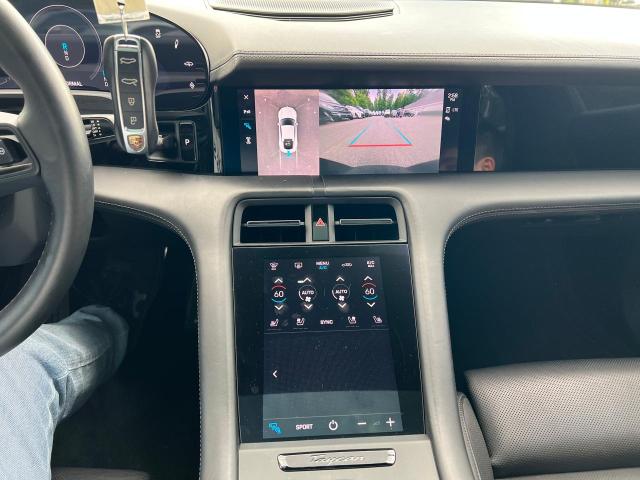2020 PORSCHE TAYCAN | WP0AC2Y10LSA71456
 ❯
❯
Specifications
6
~$250,000
Engine:
Torque: 1,340 Nm
0–100 km/h: ~2.2 s
The Porsche Taycan Turbo GT stands as a testament to Porsche's relentless pursuit of performance, even in the electric era. With a staggering 1034 PS (1020 hp) on tap, it propels from 0 to 100 km/h in just 2.2 seconds, rivaling the acceleration of top-tier supercars. This electrifying performance is not just about straight-line speed; the Taycan Turbo GT boasts a top speed of 305 km/h, ensuring its prowess on both road and track.
Beyond raw numbers, the Taycan Turbo GT embodies Porsche's commitment to driving dynamics. Its adaptive suspension, precise steering, and advanced torque vectoring systems deliver a driving experience that is both engaging and confidence-inspiring. The low center of gravity, courtesy of its battery placement, enhances cornering stability, making it a true driver's car.
Moreover, the Taycan Turbo GT doesn't compromise on practicality. With a range of up to 630 km (WLTP), it combines daily usability with exhilarating performance. Its design seamlessly blends aerodynamic efficiency with Porsche's iconic styling cues, resulting in a vehicle that is as visually striking as it is technologically advanced.
Body Styles
Sedan (Taycan / 4S / GTS / Turbo / Turbo S) – a sleek, low-slung four-door EV sedan with a coupe-like roofline, wide fenders, and Porsche’s signature LED light bar at the rear. It combines a sports car driving experience with EV innovation. The Turbo and Turbo S variants include adaptive suspension, torque vectoring, and carbon-ceramic brakes for high-performance driving.
Wagon (Taycan Sport Turismo / Cross Turismo) – a shooting brake-style body with increased practicality. The Sport Turismo has the same ride height as the sedan, while the Cross Turismo features raised suspension, body cladding, and gravel-ready drive modes. Both offer folding rear seats, a usable trunk, and optional roof rails, making them ideal daily or weekend EVs with Porsche performance DNA.
Model Name Meaning (Manufacturer)
“Taycan” is derived from Turkish, roughly meaning “soul of a spirited young horse”, aligning with Porsche’s logo and identity. The name was chosen to reflect a new era of electric mobility, connecting heritage with progress. “Turbo” and “Turbo S” are used symbolically in Porsche’s EV lineup to indicate performance levels, though no turbos are involved. “Cross Turismo” highlights crossover utility, while “Sport Turismo” references Porsche’s fast-wagon roots.
Model Name Meaning (Languages)
“Taycan” is globally unique and phonetically smooth across markets. It avoids alphanumerics to create a distinct electric identity. Despite being fully electric, the use of legacy performance terms like Turbo is meant to position the Taycan within Porsche’s familiar high-performance hierarchy, making it accessible yet aspirational to long-time enthusiasts and new EV buyers alike.
Body & Interior Colors and Rims
Taycans are available in a wide palette of paints, including Porsche classics like Crayon, Carmine Red, Frozen Blue Metallic, Jet Black, Chalk, Frozenberry, and Neptune Blue. The Paint to Sample program allows virtually any shade, including historical 911 colors, matte finishes, and exclusive triple-layer metallics.
Interior options range from Club Leather OLEA and Race-Tex (vegan) to two-tone stitching, embossed crests, wood trim, matte carbon, or aluminum inlays. Standard upholstery themes include Slate Grey, Beige, Black/Bordeaux, and Graphite Blue/Chalk. The curved 16.8” digital instrument cluster is accompanied by dual center screens, with an optional passenger-side display and augmented reality head-up display.
Wheels range from 19 to 21 inches, with aero-optimized designs like Mission E, Turbo Aero, RS Spyder, and Exclusive Design. Caliper colors vary by trim and include black, red, white (on Turbo S), or acid green (on plug-in hybrids). Carbon-ceramic brakes and rear-axle steering are optional on most AWD models.
Top Expensive Options
- Porsche Ceramic Composite Brakes (PCCB): ~$9,000
- Adaptive Sport Seats with Memory + Massage: ~$5,000
- Burmester 3D High-End Surround Sound System: ~$7,000
- Porsche Dynamic Chassis Control Sport (PDCC): ~$4,500
- Rear-Axle Steering: ~$2,000
- Head-Up Display with AR Navigation: ~$1,800
- SportDesign Package with Painted Diffuser + Spoilers: ~$4,200
- Panoramic Glass Roof with Variable Light Control: ~$3,500
- 21” Exclusive Design Aero Wheels: ~$4,000
- Paint to Sample / Custom Color: ~$12,000–25,000+
vs Competitors
The Porsche Taycan entered the electric vehicle market in 2019 as Porsche’s first all-electric production car, instantly redefining expectations for performance EVs. Unlike many of its competitors that focus primarily on range, size, or autonomous tech, the Taycan prioritizes driving dynamics, build quality, and emotional engagement — offering a uniquely Porsche interpretation of what an EV should be. It competes most directly with the Tesla Model S, Audi e-tron GT, Lucid Air, Mercedes EQE/EQS, and to a lesser extent, high-performance EVs like the BMW i5 M60 or BMW i7.
Compared to the Tesla Model S, the Taycan trades outright range and tech gimmicks for a more cohesive and analog-like driving experience. While Tesla leads in range and software-based features like Autopilot, the Taycan offers vastly superior steering feedback, ride composure, and build quality, especially in corners or at high speeds. The Taycan also benefits from 800-volt architecture, enabling significantly faster charging and consistent high-output performance, where Tesla often throttles power under sustained loads.
Against the Audi e-tron GT, which shares the same J1 platform, the Taycan offers sharper suspension tuning, a lower driving position, and a sportier cockpit layout. The Audi leans slightly more toward comfort and tech-luxury styling, whereas the Taycan emphasizes driver involvement and engineering purity — even among the electric elite.
The Lucid Air impresses with its massive range, luxurious cabin, and innovative design, but it lacks the Taycan’s cohesive chassis tuning and real-world sportiness. Lucid focuses on redefining luxury and efficiency, while Porsche maintains its identity by building an EV that feels like a sports car, not just an electric sedan.
Compared to the Mercedes EQS or EQE, the Taycan is firmer, more responsive, and aimed at enthusiasts. Mercedes focuses on digital luxury and comfort, with ultra-minimalist interiors and massive screens. Porsche, by contrast, keeps the driver at the center, with physical controls, a performance-tuned suspension, and a cabin design that mirrors its combustion-engined siblings.
Lastly, the Taycan holds an edge over BMW's i5 M60 and i7 when it comes to handling precision and emotional delivery. While BMW’s latest EVs are powerful and well-equipped, they can feel heavier and more insulated. The Taycan’s low-slung, purpose-built EV platform makes it one of the most agile four-door electric cars available, particularly in trims like the GTS or Turbo S.
Fun Fact
The Taycan was the first production car with an 800-volt electrical system, allowing faster charging, lighter cabling, and more consistent high-power output. It can recover up to 265 kW in regen braking and can charge from 5% to 80% in just over 20 minutes on a 270 kW DC fast charger – outperforming nearly every other EV in its class in real-world fast charging.
Lot Details
-
Sale Date18/Jun/2025
-
Lot Number60939295
-
Sale document
-
Location
-
Odometer152,624 miles (245,624 km)
-
Primary Damage:MINOR DENT/SCRATCHES
-
Fuel
-
Drive Type
-
Color
Final Bid Porsche Taycan (2020)
$23,300
$49,794
$96,000
Specifications
6
~$250,000
Torque:
0–100 km/h:
The Porsche Taycan Turbo GT stands as a testament to Porsche's relentless pursuit of performance, even in the electric era. With a staggering 1034 PS (1020 hp) on tap, it propels from 0 to 100 km/h in just 2.2 seconds, rivaling the acceleration of top-tier supercars. This electrifying performance is not just about straight-line speed; the Taycan Turbo GT boasts a top speed of 305 km/h, ensuring its prowess on both road and track.
Beyond raw numbers, the Taycan Turbo GT embodies Porsche's commitment to driving dynamics. Its adaptive suspension, precise steering, and advanced torque vectoring systems deliver a driving experience that is both engaging and confidence-inspiring. The low center of gravity, courtesy of its battery placement, enhances cornering stability, making it a true driver's car.
Moreover, the Taycan Turbo GT doesn't compromise on practicality. With a range of up to 630 km (WLTP), it combines daily usability with exhilarating performance. Its design seamlessly blends aerodynamic efficiency with Porsche's iconic styling cues, resulting in a vehicle that is as visually striking as it is technologically advanced.
Body Styles
Sedan (Taycan / 4S / GTS / Turbo / Turbo S) – a sleek, low-slung four-door EV sedan with a coupe-like roofline, wide fenders, and Porsche’s signature LED light bar at the rear. It combines a sports car driving experience with EV innovation. The Turbo and Turbo S variants include adaptive suspension, torque vectoring, and carbon-ceramic brakes for high-performance driving.
Wagon (Taycan Sport Turismo / Cross Turismo) – a shooting brake-style body with increased practicality. The Sport Turismo has the same ride height as the sedan, while the Cross Turismo features raised suspension, body cladding, and gravel-ready drive modes. Both offer folding rear seats, a usable trunk, and optional roof rails, making them ideal daily or weekend EVs with Porsche performance DNA.
Model Name Meaning (Manufacturer)
“Taycan” is derived from Turkish, roughly meaning “soul of a spirited young horse”, aligning with Porsche’s logo and identity. The name was chosen to reflect a new era of electric mobility, connecting heritage with progress. “Turbo” and “Turbo S” are used symbolically in Porsche’s EV lineup to indicate performance levels, though no turbos are involved. “Cross Turismo” highlights crossover utility, while “Sport Turismo” references Porsche’s fast-wagon roots.
Model Name Meaning (Languages)
“Taycan” is globally unique and phonetically smooth across markets. It avoids alphanumerics to create a distinct electric identity. Despite being fully electric, the use of legacy performance terms like Turbo is meant to position the Taycan within Porsche’s familiar high-performance hierarchy, making it accessible yet aspirational to long-time enthusiasts and new EV buyers alike.
Body & Interior Colors and Rims
Taycans are available in a wide palette of paints, including Porsche classics like Crayon, Carmine Red, Frozen Blue Metallic, Jet Black, Chalk, Frozenberry, and Neptune Blue. The Paint to Sample program allows virtually any shade, including historical 911 colors, matte finishes, and exclusive triple-layer metallics.
Interior options range from Club Leather OLEA and Race-Tex (vegan) to two-tone stitching, embossed crests, wood trim, matte carbon, or aluminum inlays. Standard upholstery themes include Slate Grey, Beige, Black/Bordeaux, and Graphite Blue/Chalk. The curved 16.8” digital instrument cluster is accompanied by dual center screens, with an optional passenger-side display and augmented reality head-up display.
Wheels range from 19 to 21 inches, with aero-optimized designs like Mission E, Turbo Aero, RS Spyder, and Exclusive Design. Caliper colors vary by trim and include black, red, white (on Turbo S), or acid green (on plug-in hybrids). Carbon-ceramic brakes and rear-axle steering are optional on most AWD models.
Top Expensive Options
- Porsche Ceramic Composite Brakes (PCCB): ~$9,000
- Adaptive Sport Seats with Memory + Massage: ~$5,000
- Burmester 3D High-End Surround Sound System: ~$7,000
- Porsche Dynamic Chassis Control Sport (PDCC): ~$4,500
- Rear-Axle Steering: ~$2,000
- Head-Up Display with AR Navigation: ~$1,800
- SportDesign Package with Painted Diffuser + Spoilers: ~$4,200
- Panoramic Glass Roof with Variable Light Control: ~$3,500
- 21” Exclusive Design Aero Wheels: ~$4,000
- Paint to Sample / Custom Color: ~$12,000–25,000+
vs Competitors
The Porsche Taycan entered the electric vehicle market in 2019 as Porsche’s first all-electric production car, instantly redefining expectations for performance EVs. Unlike many of its competitors that focus primarily on range, size, or autonomous tech, the Taycan prioritizes driving dynamics, build quality, and emotional engagement — offering a uniquely Porsche interpretation of what an EV should be. It competes most directly with the Tesla Model S, Audi e-tron GT, Lucid Air, Mercedes EQE/EQS, and to a lesser extent, high-performance EVs like the BMW i5 M60 or BMW i7.
Compared to the Tesla Model S, the Taycan trades outright range and tech gimmicks for a more cohesive and analog-like driving experience. While Tesla leads in range and software-based features like Autopilot, the Taycan offers vastly superior steering feedback, ride composure, and build quality, especially in corners or at high speeds. The Taycan also benefits from 800-volt architecture, enabling significantly faster charging and consistent high-output performance, where Tesla often throttles power under sustained loads.
Against the Audi e-tron GT, which shares the same J1 platform, the Taycan offers sharper suspension tuning, a lower driving position, and a sportier cockpit layout. The Audi leans slightly more toward comfort and tech-luxury styling, whereas the Taycan emphasizes driver involvement and engineering purity — even among the electric elite.
The Lucid Air impresses with its massive range, luxurious cabin, and innovative design, but it lacks the Taycan’s cohesive chassis tuning and real-world sportiness. Lucid focuses on redefining luxury and efficiency, while Porsche maintains its identity by building an EV that feels like a sports car, not just an electric sedan.
Compared to the Mercedes EQS or EQE, the Taycan is firmer, more responsive, and aimed at enthusiasts. Mercedes focuses on digital luxury and comfort, with ultra-minimalist interiors and massive screens. Porsche, by contrast, keeps the driver at the center, with physical controls, a performance-tuned suspension, and a cabin design that mirrors its combustion-engined siblings.
Lastly, the Taycan holds an edge over BMW's i5 M60 and i7 when it comes to handling precision and emotional delivery. While BMW’s latest EVs are powerful and well-equipped, they can feel heavier and more insulated. The Taycan’s low-slung, purpose-built EV platform makes it one of the most agile four-door electric cars available, particularly in trims like the GTS or Turbo S.
Fun Fact
The Taycan was the first production car with an 800-volt electrical system, allowing faster charging, lighter cabling, and more consistent high-power output. It can recover up to 265 kW in regen braking and can charge from 5% to 80% in just over 20 minutes on a 270 kW DC fast charger – outperforming nearly every other EV in its class in real-world fast charging.










